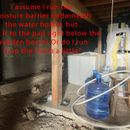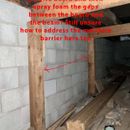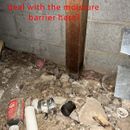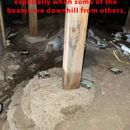Doubling up polyiso inexpensively, and other crawl space questions
Trying to encapsulate and insulate my uninsulated crawl space at 9,000 feet in northern Colorado. Got the house last January and amazingly the pipes didn’t freeze last winter at -20, but don’t want to rely on luck this coming winter. I’m reeling at a bid from a basement company of $24k for 1000 s/f of floor space with 4′ high walls, and not excited about the GWP values of spray foam, so I’m going to DIY it with polyiso boards.
I added some photos to show my crawl space, which is sloped. The uphill part of the crawl space does show history of water intrusion, but I have added rain gutters and that water intrusion doesn’t occur any longer… and we have had historic rains the last few weeks.
Wondering if anyone might be able to help with a few questions.
The plan was the run a some of the dimpled foam on the ground, put a moisture barrier on top of that and 1′ up the walls, sealed to the walls, and then glue 2 layers of polyiso on top of the masonry.
1) I’d like to get to R20 or so and not have to use a thermal barrier. I’ve sourced 1″ Thermax at R6.5 for $40 and 2″ Thermax for $80. Box stores have a similar project (but that requires a thermal/ignition barrier): RMax Pro Select R-Matte at r13 for $47, so could save some bucks using that as the first layer, and then adding the 1″ Thermax as the outer layer. Is that workable/doable/okay? Can I double that up like that?
2) The crawl space doesn’t have masonry columns in the middle, but rather 4×6 posts that are resting on concrete pads poured into the soil. How do I deal with those when it comes to wrapping the moisture barrier around the columns? Do I wrap 4-6″ up the wood, under the assumption that any moisture under the barrier will breathe out through the wood? Or do I just wrap right around the base of the wood and caulk the barrier right to the concrete pad? There are a few places where the pads are downhill from where moisture may be present during heavy rain events, so the wood would sort of sit in a divot/pit — what do I do there?
3) Similar to #2 – I’ve got 4×6 wood support columns on the walls as well. I was planning on running the poly iso boards between the supports, and then spray-foaming/caulking along the edges between the board and support. Is that sufficient?
4) I have a large masonry foundation in the middle of the crawl space that doubles as an ash pit for the original fireplace (now replaced by a wood burning fireplace insert). Do I just wrap that with the polyiso boards as well, and enclose the door where you were supposed to shovel out the ash front he fireplace?
5) I suppose I’ll need to lift the water heater and pump tank and run the moisture barrier beneath it?
Hopefully these photos will be explanatory…
Any insight is super appreciative. Thank you!
GBA Detail Library
A collection of one thousand construction details organized by climate and house part













Replies
coloradoremodeler,
1. I don't see why that won't work.
2. Probably safest to seal to the concrete several inches from the posts. Dealing with the slope and irregular pads will be easier if you can bring in a player of clear crushed gravel to provide an even surface below the floor vapour-barrier.
3. Should be fine. As with #2 I would paint the posts with preservative before running the insulation or poly.
4. I'd leave the fireplace foundation well enough alone. The vast majority of heat loss is through the walls, not that lump.
5. If the vapour-barrier is continuous and sealed, it also functions as an air and radon barrier. So if possible it's best o get it under that equipment.
According to the Home Depot website, RMax is "Exposure rated: can be left exposed in attics/crawl spaces." And "Best in class fire resistance."
https://www.homedepot.com/p/RMAX-Pro-Select-R-Matte-Plus-3-1-in-x-4-ft-x-8-ft-R-6-0-Foam-Insulation-Board-637900/313501508
If you drain the water out of the pump tank and the water heater they are easy to lift enough to slip a vapor barrier under.
I noticed the mouse poison and traps in the pictures. If you can figure out where they're getting in it would be a good idea to close it off before insulating. They love to nest in insulation. Stuffing a hole with steel wool and then sealing it with spray foam works well.
Wow, thanks for catching that... but now I'm confused!
In this pdf the install instructions say it just be covered:
https://images.homedepot-static.com/catalog/pdfImages/6b/6b782d7e-1893-42fd-96ec-954fb67a6cce.pdf
But I wonder if it's a different product? It doesn't say "pro select" in the pdf?
Yeah, in the Q&A on the HD website someone asks the question outright and the response is to call their technical support line.